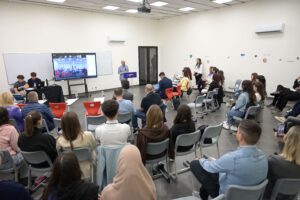21 avril 2022
Silviu-Iulian Niculescu
L2S/CNRS, Universit´e Paris-Saclay
Arben Cela, Ren´e Natowicz
LISSI, ESIEE Paris.
PhD Position
Machine Learning in Graphs : Toward Prediction of Human Behaviors’ Dynamics in Online Social Network
This PhD thesis will investigate the interplay between macro-level network topology and users’micro-level density of connections and information exchange dynamics. This interplay has key role in estimating the dynamics of behaviours, opinions and decisions at both individual and group levels, which involves machine learning in graphs.
The advent of Online Social Networks (OSNs) makes it possible large scale studies of information spreading and influence propagation that shape individual actions and decisions, and group opinions.
OSNs not only connect people. They reveal preferences, activities, and interests of individuals over time. Both online through OSNs and offline interactions impact individual thoughts, opinions and behaviors. All of them are of interest in marketing, politics, business, … This PhD thesis addresses
the question of opinions’ prediction relying on the flow of information in social networks, observed at both network level and small world level.
Much efforts have been devoted to understanding and modelling social influence phenomena that are now recognized as a key factors governing human behaviors and driving individuals’ decisions.
According to the outcome granularity one can consider macro-level and micro-level models of social influence. The former focuses on predicting the impact of a diffusion process at the network scale while the latter aims at studying social influence at the network’s user level. In this line, much research efforts have focused on defining metrics of social influence, social similarity, and social influence in order to design predictive models of the activities and interests of individuals. One core
question is the accuracy such predictions can achieve making use of individual’s social relations alone i.e. without individuals’ data.
Here the network topology is a graph. Graphs are flexible data-structures, very far from fixed neighborhood data-structures like pixels in images, just to cite an example. Because of this flexibility, present machine learning algorithms whose data representation paradigm is vector, do not fit on graphs. By contrast, graph databases are well suited to represent social networks. Native graph databases (eg. Neo4j graph databases) come with very efficient graph algorithms allowing retrieving
information and ranking nodes by flexible proximity criteria computed on flexible neighborhoods.
This makes developing machine learning algorithms in graph databases the other core question.
Contact : Silviu-Iulian Niculescu (silviu.niculescu@centralesupelec.fr), Arben Cela (arben.cela@esiee.fr), Rene Natowicz (rene.natowicz@esiee.fr).
References :
[1] Anahita Mirtabatabaei, Francesco Bullo, ’Opinion Dynamics in Heterogeneous Networks :
Convergence Conjectures and Theorems’, SIAM J. CONTROL OPTIM, Vol. 50, No. 5, pp. 2763-
2785, 2012.
[2] Ji Liu, Mengbin Ye, Brian D.O. Anderson, Tamer Basar, Angelia Nedic, ’Discrete-Time Polar
Opinion Dynamics with Heterogeneous Individuals’, 2018 IEEE Conference on Decision and Control
(CDC), Miami Beach, FL, USA, Dec. 17-19, 2018.




